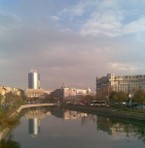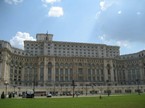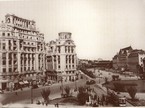Bucharest Romania
English
 Bucharest is the capital of Romania, an important political, economic, commercial, financial, cultural, tourist and one of the big cities of the world, administratively divided into six sectors. The city has been mentioned for the first time in 1459 and became the capital of Romania in 1862. Since then, suffered a series of changes and became the center of media, culture and Roman artistic scene. Architecture has been apart, which is a mixture between history, communist and modern, reflect, too, history range of the city. In the interwar period, architectural elegance and sophistication He brought the title of "Little Paris". Although a large part of the historic centre has been damaged by war, earthquakes and systematic program of Nicolae Ceausescu, the majority of space has survived in recent years suffered an expanding economic and cultural.
Bucharest is the capital of Romania, an important political, economic, commercial, financial, cultural, tourist and one of the big cities of the world, administratively divided into six sectors. The city has been mentioned for the first time in 1459 and became the capital of Romania in 1862. Since then, suffered a series of changes and became the center of media, culture and Roman artistic scene. Architecture has been apart, which is a mixture between history, communist and modern, reflect, too, history range of the city. In the interwar period, architectural elegance and sophistication He brought the title of "Little Paris". Although a large part of the historic centre has been damaged by war, earthquakes and systematic program of Nicolae Ceausescu, the majority of space has survived in recent years suffered an expanding economic and cultural. Parliament Palace, was built in order dictator Ceausescu between 1984 and 1989, is the second largest building in the world with the largest 265,000 sq m of the Pentagon after having an area of 604,000 square meters. Romanian Parliament is the supreme representative body of the Romanian people and the sole legislative authority of Romania. Parliament together with the Government have the right legislative initiative. Also, a suggestion Legislature may be advanced and by a group of at least 100,000 people with voting rights of at least a quarter of the country.
Parliament Palace, was built in order dictator Ceausescu between 1984 and 1989, is the second largest building in the world with the largest 265,000 sq m of the Pentagon after having an area of 604,000 square meters. Romanian Parliament is the supreme representative body of the Romanian people and the sole legislative authority of Romania. Parliament together with the Government have the right legislative initiative. Also, a suggestion Legislature may be advanced and by a group of at least 100,000 people with voting rights of at least a quarter of the country. Bucharest City lies in southeastern country, between Ploiesti and Giurgiu, Dâmbovita on the banks of the river that flows into Arges, a tributary of the Danube. More lakes stretching along the River Center in downtown perimeter, as Floreasca Lake, Lake or Lake Tei Center, and there is a downtown lake, Lake Cismigiu. This lake, the former pool in the old medieval city, is surrounded by Cismigiu Garden, inaugurated in 1847 by architect plans german FW Carl Meyer. Besides Cismigiu, there are two large parks, Herastrau Park (Village Museum) and Botanical Garden (the biggest in Romania and comprising over 10,000 species of plants, including exotic).
Bucharest City lies in southeastern country, between Ploiesti and Giurgiu, Dâmbovita on the banks of the river that flows into Arges, a tributary of the Danube. More lakes stretching along the River Center in downtown perimeter, as Floreasca Lake, Lake or Lake Tei Center, and there is a downtown lake, Lake Cismigiu. This lake, the former pool in the old medieval city, is surrounded by Cismigiu Garden, inaugurated in 1847 by architect plans german FW Carl Meyer. Besides Cismigiu, there are two large parks, Herastrau Park (Village Museum) and Botanical Garden (the biggest in Romania and comprising over 10,000 species of plants, including exotic).Historical vestiges in Bucharest:
- Old Court - meant a political and administrative centre of Wallachia, the most important medieval buildings XV-XVIII, the territory of the city. The fortress built during the reign of Vlad the Impaler, was designed to protect the Royal Court in a fortified center;
- New Court or Court Arsa was built by Alexander Ipsilanti in the year 1776, being seriously affected by fires and earthquakes, today can be seen only a part of the walls and cellars;
- Manuc's Inn, built by a large negustor - Manuc-drinking in the first decade of the century. XIX, is now one of the most important historical monuments and architecture of Bucharest;
- Coltea Hospital is the first hospital built by Michael backrest Cantacuzinoin year 1704, the current building dates from 1888 and represents one of the architectural models at the end of cent. XIX;
- Turret the Fire (1892-1983) was built as an observer for fires and fire that post, with a height of 50 meters, was one of the prominent buildings in Bucharest at that time, today became Museum Firemen;
- Ghica Palace built by Prince Dimitri Grigorie Ghica in 1882, is an important building, a symbol of the neoclassical style of Wallachia;
- Stirbei Palace (1835), built in the neoclassical style by the French architect Sanjouand project, is an elegant building with Greek elements that belonged to a princely family Stirbei meantime, here today being Ceramic Museum and Glass;
- University Palace (1857-1869), a massive construction project designed by architect Alexander Orascu and K. Storck, is now one of the oldest and famous institutions of higher education from Bucharest;
- Cotroceni Palace, built in the year 1893 plans by the French architect Paul Gotttereau with numerous architectural elements autohtona, was the destination of permanent residence print heir Ferdinand, now serving as the residence of the President Country;
- Palace of Justice (1890-1895), built in French Renaissance style, by Ballu A project architect, is completed by Ion Mincu, with statues at the entrance as it symbolizes the Law, Justice, Justice, truth, and Force;
- Cantacuzino Palace (1898-19000, is a baroque building with a rich interior decorations in the paintings, currently being here, George Enescu Museum.



